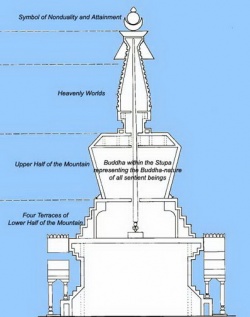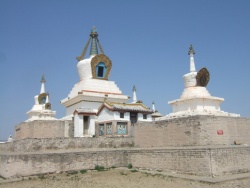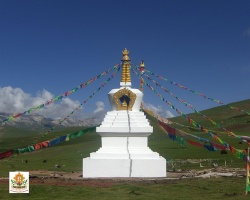Difference between revisions of "Dagobas of the Tibetan Style"
m (Text replacement - "Lhasa" to "{{Wiki|Lhasa}}") |
m (Text replacement - "Prince" to "{{Wiki|Prince}}") |
||
| Line 9: | Line 9: | ||
PALKOR DAGOBA IN GYANGZE | PALKOR DAGOBA IN GYANGZE | ||
| − | The Palkor [[Dagoba]], also called Baike Qoidain by locals, was built under the aegis of Kezhubgyai Darma Renqen, first [[disciple]] of [[Master]] Zongkapa, founder of the Yellow Sect, and by Gyangze | + | The Palkor [[Dagoba]], also called Baike Qoidain by locals, was built under the aegis of Kezhubgyai Darma Renqen, first [[disciple]] of [[Master]] Zongkapa, founder of the Yellow Sect, and by Gyangze {{Wiki|Prince}} of [[Dharma]] Raodaingun Sangpo in 1414. Construction of the [[dagoba]] took ten years. Covering an area of 2,200 square meters, the [[dagoba]] rises 32 meters high and has nine layers. It has 12 gates and 96 doors, totaling [[108]], an [[auspicious]] figure. The [[body]], 20 meters in diameter, is complete with fur [[Buddha]] halls. The Palkor [[Dagoba]] is unique in [[shape]]. The stone-clay-wood structure is square below the 5th layer and circular above the 6th layer. The top of the [[dagoba]] is an oval. Each layer has four gates adorned with flying [[dragons]], running [[lions]] and walking [[elephants]]. |
In {{Wiki|ancient India}}, semi-circular tombs were built to house the {{Wiki|remains}} of demised {{Wiki|kings}}. [[People]] of later generations have interpreted that kind of tomb to be the first appearance of [[Buddhist]] [[dagobas]]. When [[Sakyamuni]], founder of [[Buddhism]], passed away, his [[body]] was {{Wiki|cremated}}. Parts of his {{Wiki|remains}} were collected by his [[disciples]] as [[relics]] and housed in [[dagoba]]-like tombs. Many say this was the first appearance of the [[Buddhist]] [[dagobas]]. A study of the Source of Yarlung [[Doctrines]] reveals that [[Buddhists]] made their way into and settled in [[Tibet]] some 1,600 years ago. | In {{Wiki|ancient India}}, semi-circular tombs were built to house the {{Wiki|remains}} of demised {{Wiki|kings}}. [[People]] of later generations have interpreted that kind of tomb to be the first appearance of [[Buddhist]] [[dagobas]]. When [[Sakyamuni]], founder of [[Buddhism]], passed away, his [[body]] was {{Wiki|cremated}}. Parts of his {{Wiki|remains}} were collected by his [[disciples]] as [[relics]] and housed in [[dagoba]]-like tombs. Many say this was the first appearance of the [[Buddhist]] [[dagobas]]. A study of the Source of Yarlung [[Doctrines]] reveals that [[Buddhists]] made their way into and settled in [[Tibet]] some 1,600 years ago. | ||
Revision as of 20:43, 12 September 2013
Holy stupas evolved from the stupa made to hold the relics of Sakyamuni, founder of Buddhism. The Tibetans began to build such stupas in the 9th-10th centuries. The remains of an eminent monk are often treated specially and put into holy stupas in order to be well preserved. When Yexiwo (966-1036), king of the Guge Kingdom in Ngari, passed away, his body was preserved in a holy stupa. Later, when Zongkapa, founder of the Yellow Sect, died, his body was also preserved in a stupa and stored in the Gandain Monastery. Beginning with the 5th Dalai Lama, all the Dalai Lamas (except the 6th) built magnificent holy stupas for their bodies, enshrined in the Potala Palace. Glistening above the Potala Palace are the holy stupas of the eight generations of the Dalai Lama. From the 4th Panchen Erdeni, all the Panchen Erdeni have holy stupas built for their bodies as well. In the Tashilhunpo Monastery, the resident monastery of the Panchen Erdeni, there is even a hall specially built to house the holy stupas. Holy stupas can also be made for stupa burial. These stupas are unique to Tibet.
RIWOQE DAGOBA IN NGAMRING
The Riwoqe Dagoba was built between the 14th and 15th centuries, by more than 1,000 artisans over a period of 10 years, according to a blueprint worked out by Purdain Renpurqen. According to locals, the Riwoqe Dagoba is a sister of the Palkor Dagoba in Gyangze. When visitors from Gyangze saw the dagoba, they carved a model and returned to build one according to the shape of the Riwoqe Dagoba. The Riwoqe Dagoba is a stone-wood-clay-bronze structure, rising 35 meters high. It has 80 Buddha halls and 108 gates. Each Buddha hall is complete with frescos painted with figures, most of them naked, and all of them bare-footed. They have adornments of Indian, Nepalese and Bengal styles. The dagoba's top is 13 meters high, and the top boasts 9,000 small statues of Buddha.
PALKOR DAGOBA IN GYANGZE
The Palkor Dagoba, also called Baike Qoidain by locals, was built under the aegis of Kezhubgyai Darma Renqen, first disciple of Master Zongkapa, founder of the Yellow Sect, and by Gyangze Prince of Dharma Raodaingun Sangpo in 1414. Construction of the dagoba took ten years. Covering an area of 2,200 square meters, the dagoba rises 32 meters high and has nine layers. It has 12 gates and 96 doors, totaling 108, an auspicious figure. The body, 20 meters in diameter, is complete with fur Buddha halls. The Palkor Dagoba is unique in shape. The stone-clay-wood structure is square below the 5th layer and circular above the 6th layer. The top of the dagoba is an oval. Each layer has four gates adorned with flying dragons, running lions and walking elephants.
In ancient India, semi-circular tombs were built to house the remains of demised kings. People of later generations have interpreted that kind of tomb to be the first appearance of Buddhist dagobas. When Sakyamuni, founder of Buddhism, passed away, his body was cremated. Parts of his remains were collected by his disciples as relics and housed in dagoba-like tombs. Many say this was the first appearance of the Buddhist dagobas. A study of the Source of Yarlung Doctrines reveals that Buddhists made their way into and settled in Tibet some 1,600 years ago.
TIBETAN-STYLE DAGOBAS.
According to historical records, Tubo King Songtsan Gambo built a five-roof Buddhist dagoba in the Chamzhub Monastery; this turned out to be the first of its kind ever built in Tibet. In 645, when the Jokhang Monastery was built, 108 monasteries were built throughout Tibet and many Buddhist dagobas were built inside these. According to historical records, when the Samye Monastery was built, its walls were complete with 1,008 small dagobas, and inside were four white, red, black and green dagobas. In the 8th century, when Buddhism settled down in Tibet, many singular and group dagobas were built. Some groups each numbered more than 200 dagobas. Generally, each group was composed of 108 dagobas. Many of them were found in Ngari, Nedong, Qoingyai, Sagya and Lhasa.
STRUCTURE OF DAGOBAS.
Materials used to build Buddhist dagobas include gold, silver, bronze, jade, stone, wood, clay and animal bones. Inside a sutra hall there is usually a small dagoba built with gold, silver, bronze, jade, wood and animal bones. Dagobas found in open air were built with clay, stone and wood. Dagobas are generally painted white, red, yellow, black and green. Most of the dagobas are painted white. Inside the dagobas are statues of Buddha, sutras, valuables and cereals.
TYPE OF DAGOBAS.
Dagobas can be built with clay, carved stone, wood, brick, jade, bronze, silver and gold, and are made individually or as a group of dagobas. Some dagobas are dozens of meters high. The Palkor Dagoba in Gyangze is complete with a sutra hall and a place where Buddhists take ritual walks. Some smaller dagobas are five to ten meters high. There are eight types of dagoba groups, representing Sakyamuni's eight stages of development or the Buddha's eight stages of spiritual changes. There are four natures of dagobas including those which house the remains of the Living Buddhas, relics, or ashes of Sakyamuni.


